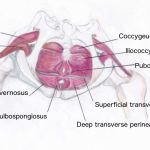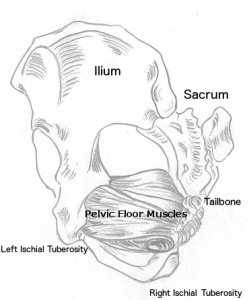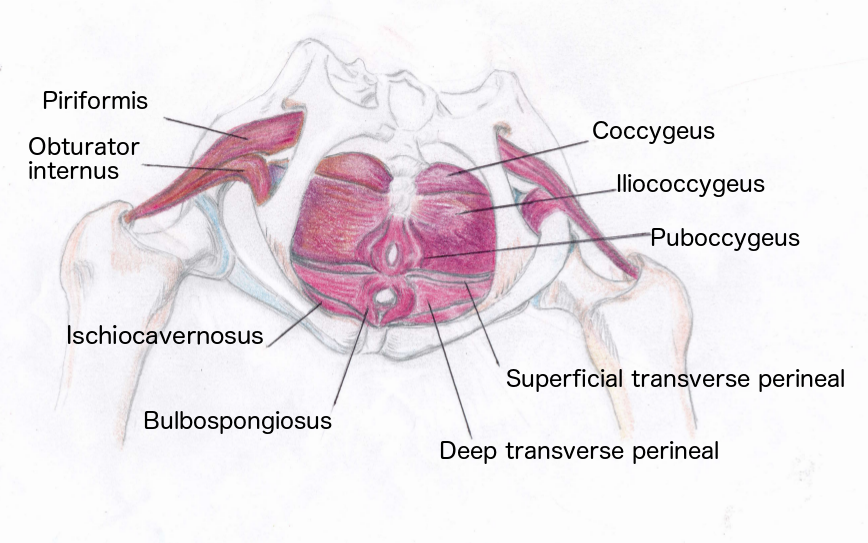Pilates and the Pelvic Floor – by Marie Wittman, PhD
I don’t have a pelvic floor, do I? (Male client)
Should I be doing Kegels to strengthen my pelvic floor?
Is Pilates good for the pelvic floor?
I just have to worry about my pelvic floor during pregnancy, right?
While these types of questions may not be commonly asked of all Pilates instructors, I am fielding these questions on a regular basis. It is certainly a product of the client base I serve, but I can tell you without a doubt that although your clients might not realize it, they will want these muscles to be as functional as their core.
It is estimated that 80% of the population will have a pelvic floor disorder at some point in their lives. This includes men and women who have not given birth. While pelvic floor disorders are commonly associated with pregnancy, they are not intrinsically caused by pregnancy or birthing. The human body is great at adapting to the changes natural in pregnancy and birthing as long as movement is a good percentage of an expecting mom’s day.
Fundamentally, it is the quantity and quality of inactivity in modern lifestyles that renders all of us, not just pregnant women, susceptible to failure of the pelvic floor muscles. This is why some of my initial conversations with clients seeking care for pelvic floor health involve a lot of discussion about making changes to how much they sit, how they sit when sitting, what other exercise they do, how much time they spend outdoors, how much they walk and in what environments, how long their daily commute to work is, and much more. This is because, although there is some specific work to be done to improve the ability of the pelvic floor muscles to engage and yield, it is truly a whole body issue and so the solution needs to be framed as a whole body, whole life type of solution.
That said, there is plenty of great things we can do in the studio to help our clients. I will discuss a few of the many exercises that are beneficial for clients with pelvic floor issues or suspected pelvic floor issues. I will also mention some exercises that should be avoided when teaching a client with issues related to pelvic floor, which includes sacroiliac joint pain, pubic symphysis pain, low back pain, and any hip issue.
First of all, let’s quickly look at where these muscles are located and to what bones they attach.
Broadly speaking, pelvic floor muscles attach at the anterior and posterior surfaces of the pelvis (at the pubis and at the coccyx and sacrum) and at the ischial tuberosities. While I highly recommend learning more about all the muscles that make up the group referred to collectively as the pelvic floor muscles, I find that this description is sufficient information for all of my clients – too much more and their eyes tend to glaze over.
The pelvic floor muscles serve the main purpose of supporting the weight of the abdominal and pelvic organs. With this function in mind then, functional pelvic floor muscles will be strong enough to support the weight of the organs at rest and during movement. We can think of this as the Goldilocks strength profile.
Should the weight of the organs superior to the pelvic floor muscles increase, say during pregnancy or with weight gain, the muscles will naturally adapt to the situation when given the mechanical stimulus to do so. A good frequency of movement and varied movement on a daily basis is really all that is needed.
Kegels are not necessary. Yes, I said it; Kegels are not important for functional pelvic floor muscles. From an evolutionary perspective, the pelvic floor muscles did not evolve to do Kegels. The daily activity that was once a requirement to survive kept these muscles functional quite naturally. We no longer live within a natural environment, however, so we will need to address the issues that arise because of our modern lifestyles – something of which Joe was well aware.
Kegels are, at best, a temporary fix, and at worst, detrimental. Kegels do not necessarily improve the functional strength of the pelvic floor muscles. In fact, Kegels or similar concentric contraction (or action) exercises run the risk of actually weakening the pelvic floor muscles. A muscle can only “be strong” (or generate force) as long as there is leverage to take advantage of within the smallest unit of muscle (the sarcomere). An exercise protocol that only trains the concentric action (as Kegels do) can lead to a situation where the sarcomeres no longer have leverage to generate force.
As you can see, concentric action is therefore only part of the picture. There are some situations that will call for strengthening the concentric action of the pelvic floor muscles. The primary example is postpartum women. But many people today have already been engaging the pelvic floor muscles concentrically – perhaps with little awareness that they are doing so – and they have no idea of how to allow the muscles to yield. Nor do they have the alignment that will promote eccentric action in natural movements like walking.
Deciphering what a particular client’s situation is does require some expert knowledge but I think it is a good beginning if more of us teachers are aware that the matter is not a one exercise fits all situation. While the following exercise guidelines are just a brief introduction, they will give you an idea of how to approach lesson planning should such a client walk through your door one day. From this point you can delve deeper into the subject (through continuing education and study) if working with this population interests you. It is a very rewarding population to work with.
Overarching Principle: The goal is to effectively strengthen the pelvic floor muscles without losing their ability to yield.
Pilates Exercises To Include
Exercises that incorporate concentric and eccentric action of the gluteal muscles, hamstrings, abductors, and deep hip rotators.
Going Up Front on the High Chair and/or Wunda Chair
Watch that the knee joint stays still and instruct your client to think of the muscles pulling/lifting the pelvis and torso up over the knee on the top of the chair. Leaning in/forward on the movement should be limited to only what is necessary and progression would be to gradually decrease lean until torso is vertical.
Leg Circles on the Cadillac or Reformer
Emphasize a slow controlled action on the return portion of the circles.
Pilates Exercises To Avoid
Exercises that involve sitting on the sacrum or tailbone.
Rolling Like A Ball
Stomach Massage Series
Short Box Series: Round and Tree
Monkey on the Cadillac (with the Tower set up)
 Marie Wittman is a Senior Teacher Trainer and Certified Pilates Teacher. She holds a PhD in medical history from Queen Mary, University of London and has founded Art and Science of Balance as a platform for educating the public about aligned movement and for providing unique continuing education to Pilates instructors. She teaches and writes about all aspects of optimal health, and is presently developing workshops on movement and women’s reproductive health.
Marie Wittman is a Senior Teacher Trainer and Certified Pilates Teacher. She holds a PhD in medical history from Queen Mary, University of London and has founded Art and Science of Balance as a platform for educating the public about aligned movement and for providing unique continuing education to Pilates instructors. She teaches and writes about all aspects of optimal health, and is presently developing workshops on movement and women’s reproductive health.
Well known and respect in the Pilates world, she has taught in Los Angeles, London, Paris, Chicago, and now back in Los Angeles. In her travels she has had the good fortune to further her own study of Pilates with beloved teachers like Kathryn Ross-Nash, Brooke Siler, Jay Grimes, and Peter Fiasca. She has also dedicated time and resources to broadening her education through studying and researching everything from kinesiology and biomechanics to holistic health and wellness approaches.
Marie is quite active in the Authentic Pilates Union, serving as the committee head in the Charity Committee and as a committee member in the Education Committee.
You can reach Marie at marie@artandscienceofbalance.com



